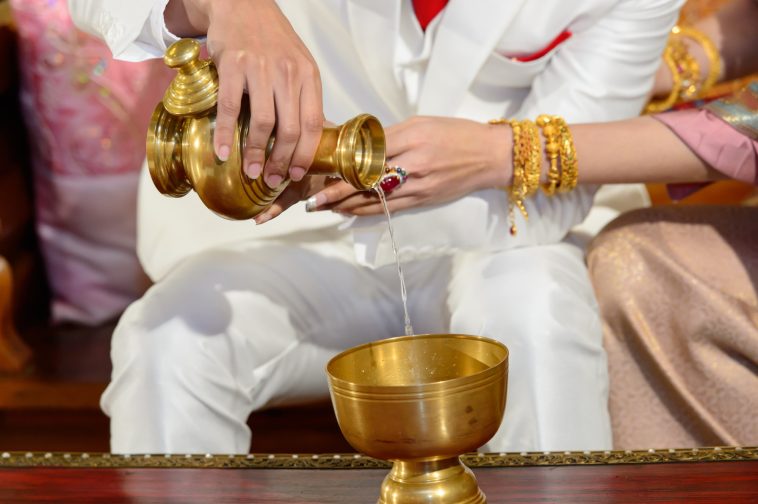Looking to ‘dress to impress’ during your wedding? Want to have a wedding that will hop across a period? If you’re planning a Viking wedding, you can have all that.
Viking weddings date as far back as the 8th century. It was the most lavish wedding you could have at the time. The traditions we see today combine their own Viking traditions and their interactions with other cultures.
Ready to plan a wedding fit for Nordic Gods and Goddesses? Here’s how you plan Viking wedding traditions.
1. The Exchange of Swords
Viking weddings were grand affairs filled with customs and rituals that reflected the rich cultural heritage of the Norse people. Among the many traditions, one that stood out as particularly unique and significant was the exchange of swords. This ritual held deep symbolic meaning and played a crucial role in cementing the bond between the bride and groom and their commitment to protect and defend their new family.
In Viking society, the sword held immense importance. It was not just a weapon but also a symbol of honor, status, and power. It represented the strength and courage of the warrior, embodying the ideals that the Vikings held dear. Therefore, it was only fitting that the exchange of swords became a pivotal part of their wedding ceremonies.
During the wedding, the bride and groom would present each other with swords as a symbol of their union. This act signified the joining of their households and the formation of a new family. The couple demonstrated their mutual commitment to protect and support one another by exchanging swords, just as a warrior would defend their people and territory.
2. The Blessing of the Ancestors
Viking weddings were steeped in ancient Norse customs and rituals, each with profound meaning and significance. Among these cherished traditions, the ancestors’ blessing held a special place. It was a solemn and spiritual act that honored the past, sought guidance for the future, and symbolized the deep connection between the newlywed couple and their ancestral lineage.
Ancestors held a revered position in Viking culture. They were believed to possess wisdom, strength, and the ability to influence the lives of their living descendants. The ancestors’ blessing during a wedding allowed the couple to acknowledge their roots and seek the support and guidance of those who came before them.
As part of this tradition, the bride and groom would visit a burial mound or a sacred site associated with their ancestors. These places were considered sacred as a link between the world of the living and the realm of the departed.
3. The Sip of Mead
Viking weddings were joyous occasions filled with revelry, feasting, and unique customs. Among these traditions, the sip of mead held a special place, adding a touch of romance and mystique to the celebration. Mead, a fermented beverage made from honey, played a significant role in Viking culture, and its inclusion in wedding ceremonies symbolized love, unity, and the hopes for a fruitful and harmonious marriage.
Mead held great importance in Norse mythology and folklore. It was often associated with fertility, vitality, and poetic inspiration. As such, it became a natural choice to be featured prominently in Viking weddings, marking the beginning of a new chapter in the bride and groom’s lives.
The newly married couple would partake in a shared cup of mead during the wedding festivities. Sipping from the same vessel symbolized the unity and bond between them. It represented their commitment to face the challenges and joys of life together, united as one. It was believed that by sharing the mead, the couple would be blessed with luck, fertility, and a harmonious partnership.
4. The Circle Dance
Viking weddings were vibrant and lively affairs where music, dance, and celebration were central elements. Among the many customs that made these weddings unique, the circle dance, also known as the “ring dance” or “roundel,” stood out as a spirited tradition that brought people together in a joyous and rhythmic display of unity.
The circle dance was a communal dance performed by the bride, groom, and guests. It involved joining hands and forming a circle, often around a central fire or a sacred object. As the music played, the participants would move synchronously, stepping and twirling to the rhythm.
The circle dance held deep symbolic meaning in Viking weddings. The circular formation represented the eternal nature of love and the cyclical nature of life. It embodied the idea that love and relationships are continuous and ever-evolving, just as the circle has no beginning or end.
5. The Binding of Hands
Viking weddings were rich in customs and traditions, each holding deep significance and symbolic meaning. Among these cherished rituals, the binding of hands stood out as a powerful symbol of unity, commitment, and the intertwining of two lives. This tradition, rooted in Norse culture and beliefs, added a profound and tangible representation of the couple’s union.
The bride and groom’s hands were bound together using cords or ribbons, often adorned with intricately crafted Viking rings, during the Norse wedding ceremony. This act of binding symbolized the joining of their lives, the creation of a new bond, and the commitment to stand by each other through all the joys and challenges ahead, with the viking rings serving as a tangible symbol of their enduring love and unity. It represented a physical and symbolic tie that would connect them in a profound and lasting way.
The binding of hands also echoed the concept of fate in Viking culture. It reflected the belief that the destinies of individuals are interconnected and that their lives are woven together by a greater force.
Embrace the Ancient Bond With Viking Wedding Traditions
A Viking wedding is a unique and special affair filled with cultural traditions, memorable food, and love. From the traditional wedding procession to the meaningful Viking wedding vows and symbolic exchange of weapons, a Viking wedding is truly one of a kind.
Why not so explore what Viking wedding traditions have to offer? You can find out today!
Was this article helpful to you? If so, make sure to check out our blog for more useful information and resources.



